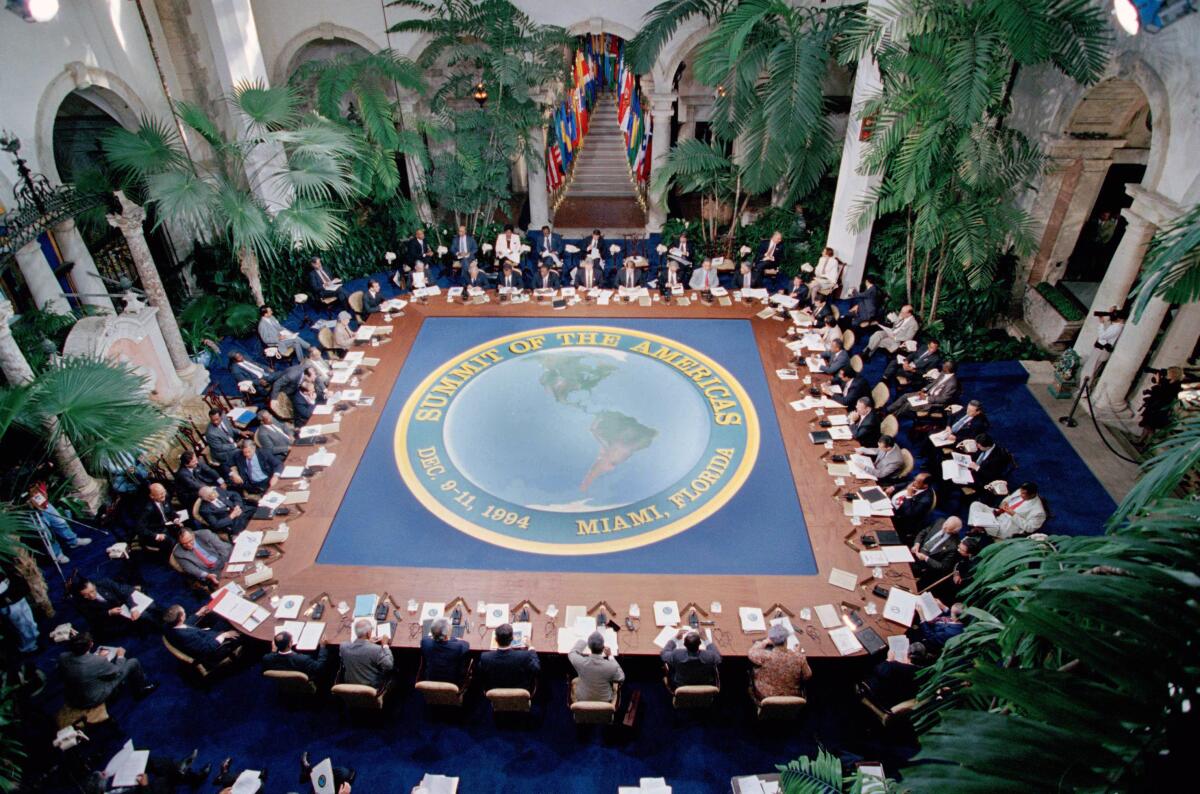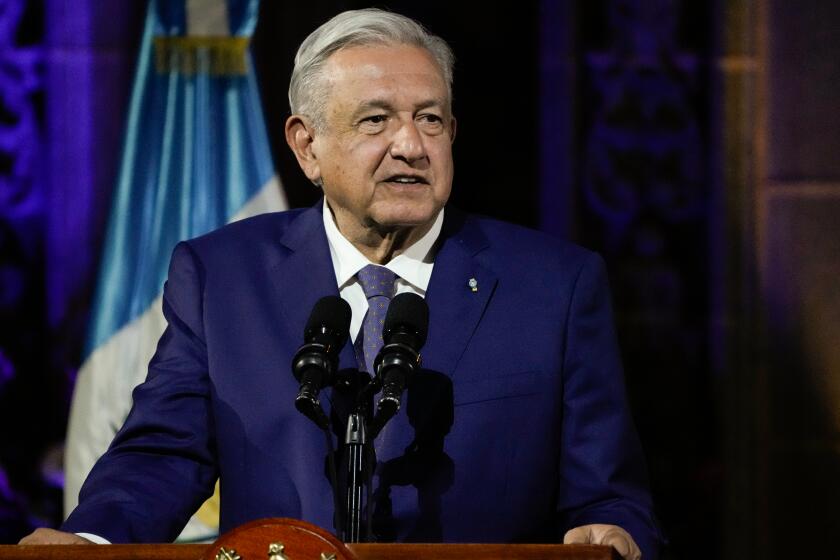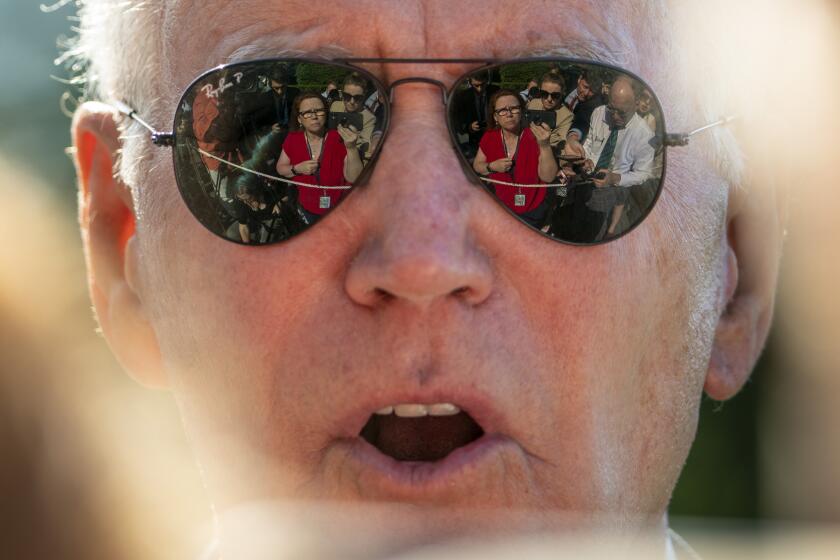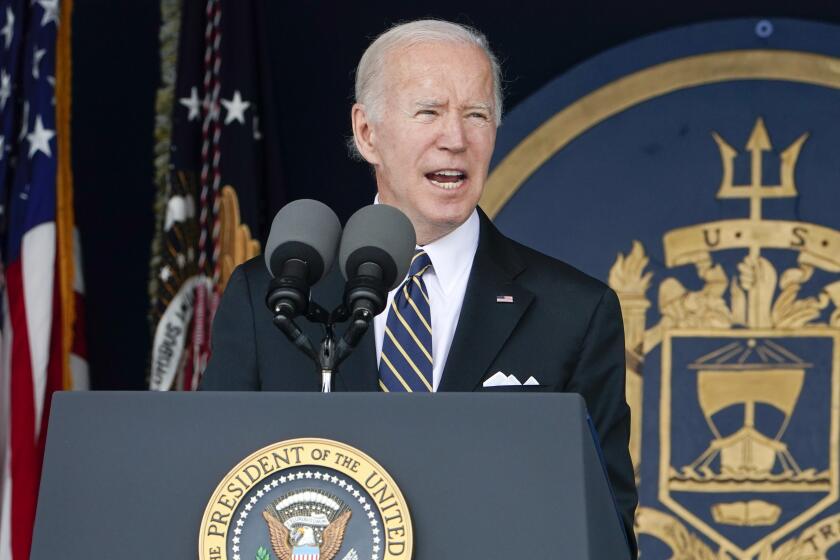Summit of the Americas opens in L.A. as U.S. grapples with deteriorating relations and influence

- Share via
WASHINGTON — It was the early 1990s, and the Western world seemed full of promise. The Soviet Union had collapsed, and the Cold War that had gripped and shaped global politics for decades was over.
So were many of the wars in Central America and some of the most intractable and brutal military dictatorships in South America, from Argentina and Chile to Brazil.
Then-President Clinton seized on the moment and the Summit of the Americas was born, with the inaugural event held in Miami in 1994. All of the countries of the Western Hemisphere except Cuba joined to debate trade, prosperity, immigration and democracy. And every one of the governments involved had been democratically elected, a sign of major progress.
Now, as the U.S. prepares to host the summit in Los Angeles this week, the first time the event has been hosted in this country since 1994, many of those involved with the inaugural effort are wondering what happened to the spirit of collaboration, and why division and acrimony have come to overshadow the joint effort.
And an even more existential question remains: Has this type of summit outlived its usefulness?
“It was a good moment,” Mack McLarty, Clinton’s special representative to the Summit of the Americas, said in an interview, recalling the events of 1994. “Cooperation, trust and relationship were truly there. It was a rising tide.”
McLarty said he holds out hope that President Biden‘s administration can “set up a bridge” to reengage with other countries in the region. But many believe the window that opened nearly 30 years ago has for the most part closed. Progress from what was seen as a watershed moment in 1994 was unraveling before the decade was out.
A brewing boycott over the invitation list to this year’s Summit of the Americas, planned for Los Angeles next month, has threatened to overshadow the meeting’s agenda.
The most glaring evidence of regression has come in the form of decisions or threats from several leaders to boycott the event, a position unheard of in 1994 and in most summits that have occurred since, taking place every three or four years. That problem has thrown the White House’s preparations for the summit into a chaotic scramble, creating bad optics for a president who has prided himself on his familiarity with Latin America.
Just a few days before the summit‘s Monday start, the White House and State Department again declined to confirm which nations would attend, having demurred for weeks when asked about invitations to the event.
As many of the region’s governments turn away from democracy and an emphasis on the rule of law, they feel freer to disengage from the U.S., where democratic principles have also been struggling. Mexico’s president, Andrés Manuel López Obrador, has said he won’t attend after the Biden administration announced it would not invite Cuba, Venezuela or Nicaragua. Bolivia followed Mexico’s lead, and several Central American countries are still on the fence.
“The diminishing influence of the United States in Latin America is a byproduct of toxic polarization” both here and to the south, said Manuel Orozco, an expert at the Inter-American Dialogue think tank. “We haven’t had the leadership to show why democracy matters. Politics and democracy are not talking to each other.”
The Biden administration has downplayed expectations for the summit in an apparent attempt to spare itself embarrassment, insisting it doesn’t really matter if some countries don’t attend.
“Look, I mean, with Mexico and those others, we have made very clear that participation won’t impact cooperation or even a level of ambition [that existed] certainly before — well before the summit,” Juan Gonzalez, the head of Western Hemisphere affairs at the U.S. National Security Council, said in a telephone conference with journalists.
The Summit of the Americas in Los Angeles next week will highlight migration, COVID-19 and climate change. But its guest list remains a mystery.
Still, U.S. officials have emphasized immigration will be a centerpiece issue of the summit. Some experts have questioned what progress can be made if Mexico and some of the Central American countries that are the sources of most of the illegal immigration into the U.S. are not present at the event. The summit will also focus on other immigration issues, namely the millions of Venezuelans who have left their country to settle in neighboring Colombia and Brazil, along with other South American nations.
Cynthia Arnson, a longtime Latin America specialist and distinguished fellow at the Wilson Center research institute, said that “some of the countries may be playing coy [about their attendance] to extract maximum benefits.”
For example, Brazil’s right-wing populist President Jair Bolsonaro announced he would not attend — until the White House promised him a bilateral meeting with Biden. Similarly, Argentina’s leftist President Alberto Fernández was on the fence until a couple of days ago, after Biden telephoned him personally.
“There is no question that U.S. influence is less today than in previous decades,” Arnson added. “That said, at a time of erosion of democracy throughout the region, the Biden administration is taking the lead in defending democracy.”
Another game-changing factor in the shifting relations: China.
In 1994, the United States was the only game in town, with an economy much larger than any other country in the hemisphere. China was not the player it is today, and many countries still had diplomatic relations with Taiwan, not Beijing.
The conference is expected to face issues that include boosting economic growth, combating climate change, slowing migration and addressing the pandemic.
But today, China has grown exponentially and has made deep inroads into Latin America through its $4.3-trillion Belt and Road infrastructure and import-export initiative, of particular appeal to governments that don’t want to be challenged on democratic practices or human rights.
“The U.S. is giving this constant message to Latin American countries: Don’t do business with China. It’s bad for you,” Arnson said. “But what the U.S. has to offer is still not clear. ... The United States needs to show it’s putting skin in the game.”
She noted that while China is pouring money into the region, several overtures from Latin American nations about free-trade agreements with the U.S. have gone unanswered. Trade is an increasingly polarizing domestic political issue, further complicating any steps by Biden.
A hallmark of the 1994 summit was a proposal for the Free Trade Area of the Americas, an ambitious plan to eliminate trade barriers throughout the region. However, it fell apart a few years later when officials could not agree on final terms.
“We always refer to the golden decade, the ‘90s, when it comes to democracy and human rights,” said Santiago Cantón, a former human rights official in his native Argentina and now a visiting scholar at the American University Washington College of Law. “Right now the situation is completely different,” he added, noting severe deterioration of democracy throughout the hemisphere.
Current and former officials present at the first Summit of the Americas agreed that the spirit of 1994 is all but dead.
“From our perspective, it was an exciting opportunity with Latin America and the Caribbean,” said Eric Farnsworth, who worked with McLarty in the Clinton White House and is now vice president of the Council of the Americas and Americas Society. “You had mutual interests. It was a region deciding to come together. And it was a different leadership class, more technocratic, focused on growth. There was a chance to promote a different path.”
Farnsworth and others say the halcyon days of 1994 began to fall away just five years later. In Venezuela, former military commander Hugo Chávez, a charismatic, firebrand socialist, won an election and was sworn in as president. He stayed in power until his death in 2013, buoyed by spikes in the price of oil, Venezuela’s main export. His hand-picked successor, Nicolás Maduro, oversaw the destruction of Venezuela’s economy, healthcare system and any remaining democratic freedoms.
Chávez inspired leftists in Bolivia, Ecuador, Nicaragua and Argentina. But on both the left and right, there were presidents and prime ministers who sought to remain in power indefinitely, or at least beyond the term limits set in most countries. They had little patience to be lectured on democracy and human rights by the U.S., where those commitments are no longer ironclad.
The Sept. 11, 2001, terrorist attacks in New York and Washington also drastically shifted the United States’ focus and transformed its interests.
Then, in the mid-2000s, China began its move, hungry for Latin America’s vast resources of raw materials, energy and other commodities. China arrived offering big loans, albeit with strings attached.
The confusion and disarray over the 2022 Summit of the Americas is also fueling discussion about whether such meetings continue to be useful to those who participate. Some experts have said an event gathering together a large and disparate collection of countries for whom only general geography is shared is no longer workable. Others have suggested a U.S. president should meet with smaller groups of the region’s leaders to discuss shared interests.
“My sense is there is a role for summitry ... but we need to think strategically rather than geographically,” Farnsworth said.
In addition, the design of the conference — which is attended by countries with populations ranging from huge to very small — makes it difficult to achieve any sort of unified action on regional issues. In fact, the last five summits have failed to produce a joint declaration, the usual crowning coda of such events. U.S. officials say they hope to produce a Los Angeles declaration on immigration this year.
“Nothing gets achieved through the formal mechanisms of the summit,” said Dan Restrepo, a former special assistant to President Obama who coordinated his participation in two Summits of the Americas. “That’s how dysfunctional the summit system itself is. But you can do things at the summit that can be useful in that it’s an action-forcing event.”
Another concern among many who follow Latin American affairs is whether the U.S. will sustain focus and interest in the region after the summit, or simply hold the event and move on.
At best, some say, the Biden administration should counter the sense that the U.S. is disengaged.
“This should not be a one-and-done,” Rebecca Bill Chavez, a former Pentagon official and now president of the Inter-American Dialogue, said Friday in a video conference. “But a launching pad.”
Times staff writer Courtney Subramanian in Washington contributed to this report.
More to Read
Get the L.A. Times Politics newsletter
Deeply reported insights into legislation, politics and policy from Sacramento, Washington and beyond. In your inbox three times per week.
You may occasionally receive promotional content from the Los Angeles Times.














